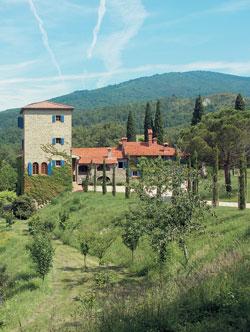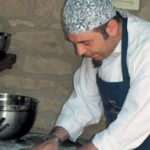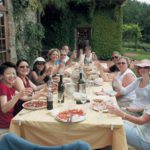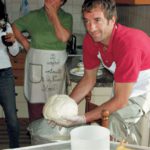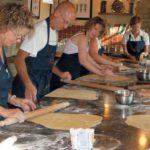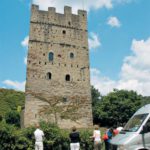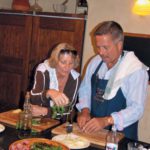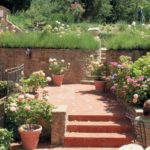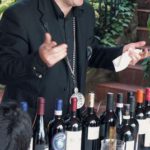The tastes and smells of Tuscany take on a new meaning under the watchful eye of chef Franco Palandra at Torre del Tartufo, one of Italy’s top cooking schools. PIXIE EMSLIE kneaded the pasta, tasted the olive oil and sampled the wine
The hills of Tuscany beckon gently under the warm summer sun as the road from Arezzo in the south-east winds its charming way through valleys, forests and farmlands. This is cooking country and anticipation was high as we approached our destination, Torre del Tartufo, a few kilometres outside Arezzo, where my husband Robin and I would spend a week learning the art of cooking Italian food. The villa is aptly named. Perched high in the hills of Monte Giovi, views stretch forever across magnificent countryside. At the cooking school, roses climb the old stone walls, giant hydrangeas glow pink and blue, and glorious beds of herbs scent the air.
Accommodation is spacious: 12 double bedrooms have en-suite bathrooms, with some of the rooms including a living room equipped with fridge and kitchenette. Manager Barbara Helmer welcomed us, herself a graduate of the cooking school and an ardent admirer of the area, its people and its food. Comfortably settled and chilled glass of wine in hand, we were soon chatting with the other international student cooks from the US, Mexico, Australia, UK and South Africa.
Eagerly we settled down for our first meal, cooked by the man who was to be our mentor, teacher and tormentor (but always with a gentle smile) – chef Franco Palandra. From the first day the pattern of the school was set. Breakfast, at the civilised time of 9am to 10:30am, was a buffet, with an array of fruit, bread, cold meat, cheese and eggs done to order. Then the morning was ours to do as we wished – walk through the hazelnut groves, lie at the enormous pool or enjoy a sauna, read a book or just sit and chat.
Lunch at 1pm was set out al fresco-style under the tree, then at 3pm reality began. We were each handed an apron, beautifully embroidered with the name of the villa, and a handsome recipe book. The kitchen boasts everything from extra-sharp knives to rolling pins and enormous pots and pans. Franco explained that the cooking lessons would be hands-on, with each of us making something different. Sometimes we’d work together, other times on our own. I was set to making a starter, vegetable millefoglie. Puff pastry for its base with a topping, the pastry mercifully of the bought variety as Franco said it wasn’t really worth the effort to make your own. It entailed frying thin rounds of aubergine, baby marrow, yellow peppers and tomato, and adding mozzarella, herbs and a fresh basil pesto sauce. And that was just a starter. Other dishes we made that day included melanzane Parmigiana, a Sicilian dish of aubergines in a thick tomato sauce, cooked with basil and mozzarella.
Then came a moment many had looked forward to – how to make gnocchi or potato dumplings. The potatoes were soft and fluffy, and combined with flour, grated Parmesan and various spices. Franco gently dropped them into boiling water to demonstrate how the gnocchi floated up once they were cooked. Then, of course, they had to have sauce – this time a mushroom-flavoured delight. During our first day we also made saltimbocca using pork loin and fresh sage, while lemon tartlets with meringue completed the picture.
Day two followed a similar pattern except that Franco had risen early to light the pizza oven. While we rolled the dough, flattened it and set it to prove, the outdoor wood-burning oven was reaching the correct temperature. Meanwhile we rustled up a pecorino cheese flan with white bean sauce, we stuffed and cooked zucchini flowers, learned how to mix a brisé dough for rolls and then made our own dough for ravioli. There was much laughter as we battled to shape the ravioli, which simply refused to come out in neat little squares. Nevertheless they tasted delicious, with their filling of spinach, ricotta cheese, grated Parmesan and nutmeg. Truffles are used in many of the recipes, sometimes with seemingly gay abandon.
At Torre del Tartufo they are grown on the estate and in summer the black truffle is found in fair numbers. The more pungent and rare white truffle is found during the winter months. Specially trained truffle-sniffing dogs visit the farms in the neighbourhood every week to search for the little delicacies, and we watched with fascination as Pepe hunted for these delights under the hazelnut and oak trees. The dog would rush around, sniffing madly, then suddenly start yelping with delight and start to dig. Instantly his trainer was there to carefully lift the truffle out of the ground and reward him. Then he would start again.
Pepe unearthed about 10 of the oddshaped fungi while we were watching. Once they were scrubbed clean of earth, Franco carefully shaved slices off the truffle and it is these that were used in the cooking, either fresh or as a truffle paste. The third day brought a complete change as the group was whisked off to experience some of the Tuscan farms on the local Agriturismo route, comparable to our wine route in the Cape. First stop was Casa Pallino where cheese is made from sheep’s milk. The first soft cheese, ravijolo is made from the curds, then from the whey comes the soft ricotta, a slightly harder cheese called ravida, and finally pecorino which is aged for up to a year. From there it was on to a magnificent privately owned castle, Castello di Porciano, which dates back to the 11th century.
One of its more famous guests was Dante Alighieri who stayed there while writing part of the Inferno in his Divine Comedy. Today the castle is owned by Martha Specht Corsi who is lovingly restoring the building and who has also written a cookbook aimed at the many foreign students who visit Florence. An absolute must in Tuscany is a visit to an olive farm and vineyard. We were hosted by Primo and Isabella de Sabbata at their farm Tenuta Il Palazzo, where we tasted some of their wines and prize-winning olive oil. The final days saw us making more advanced dishes, and under Franco’s careful instruction we produced such delights as duck râgout with porcini mushroom sauce, saffron-infused risotto, wild boar and – his pièce de résistance – rack of lamb with melted pecorino, marinated sundried tomato and black olives.
Franco won the best chef award for this recipe at the Four Seasons hotel in Milan recently. Puddings included a millefoglie with ice cream served in honey baskets. Franco arrived at Torre del Tartufo three years ago after working as a chef on cruise ships for several years. He was born in Switzerland but raised in Caserta near Naples. “I got my inspiration from my Italian mother and from my neighbour who was a chef, and who encouraged me,” he said. At the final dinner all 12 aspiring chefs paid tribute to Franco and the way in which he had coaxed us through some difficult tasks with cheerfulness and skill. We also made our farewells, knowing many new friendships had been forged over those hot stoves, friendships that would one day be renewed around the world over a good Tuscan meal.
The cooking course takes a maximum of 12 students and each course runs for one week, either at Torre del Tartufo or the nearby Casa Ombuto. Courses are conducted in English and the rates include accommodation, all meals and drinks, cooking classes and excursions. Costs for 2008 are around R22 000 per person, participating in the cooking class and sharing, or around R17 200 per nonparticipating partner, sharing. For information and prices on renting the entire villa, either selfcatering or with certain meals cooked by the chef, visit www.torredeltartufo.com or email info@ italiancookerycourse.com or call 0044-0871-720-2665.

